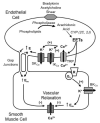Vascular pharmacology of epoxyeicosatrienoic acids
- PMID: 21081214
- PMCID: PMC3373307
- DOI: 10.1016/B978-0-12-385061-4.00002-7
Vascular pharmacology of epoxyeicosatrienoic acids
Abstract
Epoxyeicosatrienoic acids (EETs) are cytochrome P450 metabolites of arachidonic acid that are produced by the vascular endothelium in responses to various stimuli such as the agonists acetylcholine (ACH) or bradykinin or by shear stress which activates phospholipase A(2) to release arachidonic acid. EETs are important regulators of vascular tone and homeostasis. In the modulation of vascular tone, EETs function as endothelium-derived hyperpolarizing factors (EDHFs). In models of vascular inflammation, EETs attenuate inflammatory signaling pathways in both the endothelium and vascular smooth muscle. Likewise, EETs regulate blood vessel formation or angiogenesis by mechanisms that are still not completely understood. Soluble epoxide hydrolase (sEH) converts EETs to dihydroxyeicosatrienoic acids (DHETs) and this metabolism limits many of the biological actions of EETs. The recent development of inhibitors of sEH provides an emerging target for pharmacological manipulation of EETs. Additionally, EETs may initiate their biological effects by interacting with a cell surface protein that is a G protein-coupled receptor (GPCR). Since GPCRs represent a common target of most drugs, further characterization of the EET receptor and synthesis of specific EET agonists and antagonist can be used to exploit many of the beneficial effects of EETs in vascular diseases, such as hypertension and atherosclerosis. This review will focus on the current understanding of the contribution of EETs to the regulation of vascular tone, inflammation, and angiogenesis. Furthermore, the therapeutic potential of targeting the EET pathway in vascular disease will be highlighted.
Copyright © 2010 Elsevier Inc. All rights reserved.
Figures





References
-
- Adeagbo ASO, Triggle CR. Varying extracellular [K]: a functional approach to separating EDHF- and EDNO-related mechanisms in perfused rat mesenteric arterial bed. J Cardiovasc Pharmacol. 1993;21:423–429. - PubMed
-
- Archer SL, Gragasin FS, Wu X, Wang S, McMurtry S, Kim DH, et al. Endothelium-derived hyperpolarizing factor in human internal mammary artery is 11,12-epoxyeicosatrienoic acid and causes relaxation by activating smooth muscle BKca channels. Circulation. 2003;107:769–776. - PubMed
-
- Bellien J, Favre J, Iacob M, Gao J, Thuillez C, Richard V, et al. Arterial stiffness is regulated by nitric oxide and endothelium-derived hyperpolarizing factor during changes in blood flow in humans. Hypertension. 2010;55:674–680. - PubMed
-
- Bellien J, Thuillez C, Joannides R. Contribution of endothelium-derived hyperpolarizing factors to the regulation of vascular tone in humans. Fundam Clin Pharmacol. 2008a;22:363–377. - PubMed
-
- Bellien J, Thuillez C, Joannides R. Role of endothelium-derived hyperpolarizing factor in the regulation of radial artery basal diameter and endothelium-dependent dilatation in vivo. Clin Exp Pharmacol Physiol. 2008b;35:494–497. - PubMed
Publication types
MeSH terms
Substances
Grants and funding
LinkOut - more resources
Full Text Sources
Other Literature Sources

